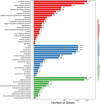Transcriptome dynamics along with expression analysis of key genes involved in fiber development between Gossypium barbadense and Gossypium darwinii
- PMID: 40410746
- PMCID: PMC12100858
- DOI: 10.1186/s12870-025-06697-2
Transcriptome dynamics along with expression analysis of key genes involved in fiber development between Gossypium barbadense and Gossypium darwinii
Abstract
The transcriptome profiling for underpinning the role of key genes controlling formation of fiber in cultivated Gossypium barbadense compared to wild allotetraploid cotton Gossypium darwinii which remained less investigated. Owing to excellent fiber quality of both Gossypium barbadense and Gossypium darwinii and information obtained via Simple Sequence Repeat (SSR) markers, two lines: Xh-18 and darwinii 5-7 were selected for transcriptome sequencing during developmental stages i.e., fiber initiation, elongation, and secondary cell wall (SCW) biosynthesis followed by 0 day after anthesis (DPA), 5DPA, 10DPA, 15DPA and 25DPA, respectively. Twelve libraries of RNA-seq were generated and sequenced individually generating approximately 818 million clean reads of Gossypium darwinii. However, for Gossypium barbadense more than 844 million clean reads were recorded. The Pearson Correlation Coefficient (PCC) analysis results indicated that gene expressions for both Gossypium barbadense and Gossypium darwinii indicated more than 90% of the commonalities at the same stage of fiber growth. However, genes found among Gossypium darwinii at 5, 6 and 7 DPA and XH-18 at 10 and 25 DPA were found disimilar. The expression quantity of RNA sequencing data, 31 genes were found common throughout all stages of DPAs in Gossypium darwinii 5-7 whereas, 377 genes were common in Gossypium barbadense XH-18 at 0, 5, 10, 15, 20, and 25 DPA stages of fiber development. Three genes XLOC_080616 (LTPG2_ARATH/ NLTL2_ARATH; GPI-anchored 2 non-specific lipid transfer protein, similar to At2 g13820), XLOC_065471 (LPAT2_ARATH/LPAT2_BRAOL 1-acyl-sn-glycerol-3-phosphate acyltransferase2), and XLOC_077416 (uncharacterized protein) shown up-regulated expression during 15 and 20 DPA for both Gossypium barbadense and Gossypium darwinii. It will also explore the possible role Gossypium barbadense DNA segment associated with development of fiber quality. Furthermore, this research will decipher the underlying process of fiber development and the possible role of genes for fiber formation in both Sea Island and wild cotton species.
Keywords: DPAs; Fiber development; Gene Functions; Single sequence repeats; Transcriptome profile.
© 2025. The Author(s).
Conflict of interest statement
Declarations. Ethics approval and consent to participate: Not applicable. Consent for publication: Not applicable. Competing interests: The authors declare no competing interests.
Figures











References
-
- Alexa A, Rahnenfuhrer J. topGO: Enrichment analysis for Gene Ontology. R package version. 2010;2:2010.
-
- Azzouz B, Ben Hassen M, Sakli F. Adjustment of Cotton Fiber Length by the Statistical Normal Distribution: Application to Binary Blends. J Eng Fiber Fabr. 2008;3(3):155892500800300300. 10.1177/155892500800300304.
-
- Bölek Y, Çokkızgın H, Bardak A. Genetic analysis of fiber traits in cotton. KSÜ Doğa Bil Derg. 2014;17(1):15–20.
MeSH terms
Substances
LinkOut - more resources
Full Text Sources

